Plant Growth and Cultivation Research Plant Culture System Program (1)
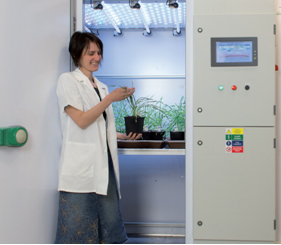
Plant culture is one of the most important routine basic experiments in biological laboratories. In previous studies, only the culture system was required to enable the seeds to germinate and basically satisfy the growth of the plants. However, in the study of truly rigorous plant physiology and ecology, traditional incubators are far from being able to meet the requirements for various reasons.
This article will introduce a series of scientific research plant culture programs based on LED light source, including SL3500 plant culture LED light source, FytoScope plant growth box and so on. These culture programs and instruments are directly designed by European plant physiology scientists to enable accurate scientific research.
Technical requirements for modern scientific research plant cultivation
1. Light source
It is well known that light is one of the most important environmental factors in plant growth. It not only provides radiant energy for plant photosynthesis, but also provides signals for plants to regulate their development. Plants are always in a changing light environment throughout their life cycle. In the long-term evolution, plants not only adapt to changes in the light environment, but also interact to change the surrounding light environment. Therefore, the incubator light source is the most important part of determining its quality.
1) Light quality
The wavelength of sunlight reaching the ground is from about 300 to 2600 nm, and the effective wavelength for photosynthesis is between 400 and 700 nm. Among them, blue light of 425-490 nm and red light of 610-700 nm contribute the most to photosynthesis, and 520-610 nm. The rate of (green) light absorbed by plants is very low (Yan Xinfang, 2009).
LED (1ight-emitting diodes), a major feature of LEDs, is the ability to emit monochromatic light of extremely high purity (Figure 1). Therefore, from the beginning of the birth of LED, red and white LEDs were used for plant cultivation.

Figure 1. Monochrome spectrum of a FytoScope LED source
In many studies, scientists hope to simulate natural sunlight to cultivate plants. It can be seen from Fig. 2 that although incandescent lamps and fluorescent lamps emit white light, their spectra are actually quite different from the solar spectrum. The most similar to the solar spectrum are the halogen and white LEDs. However, halogen lamps use a considerable amount of energy to emit near-infrared radiation in the 750-2600 nm band that plants cannot use. According to US company GE, this part of the energy accounts for 76% of the total radiant energy. At the same time, near-infrared radiation will have a strong optical radiation warming effect, and long-term exposure will cause damage to the cultivated plants. One of the great advantages of LED light sources is that they generate very little heat. This can also be seen from the spectrogram of Figure 2 that the near-infrared radiation of white LEDs is extremely low.
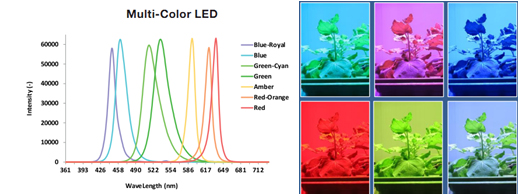
Figure 2. Spectral diagram of different light sources, upper left: sunlight; upper middle: incandescent light; upper right: fluorescent light (fluorescent light); lower left: halogen light; lower middle: cool white LED; lower right: warm white LED
In addition to providing energy to plants, light regulates a variety of physiological responses in plants directly through phytochromes and cryptochromes (Figure 3). The phytochrome has two tautomers - red light-sensitive pigment (Pr) and far-red light-sensitive pigment (Pfr). Pr absorbs red light having a wavelength of about 660 Bin, and Pfr absorbs far-red light having a wavelength of about 730 nm. The phytochrome regulates the response of many different plants to light, including photoperiod, seed germination, leaf spreading, hypocotyl elongation and de-yellowing. The cryptochrome absorbs light waves in the blue and ultraviolet range.
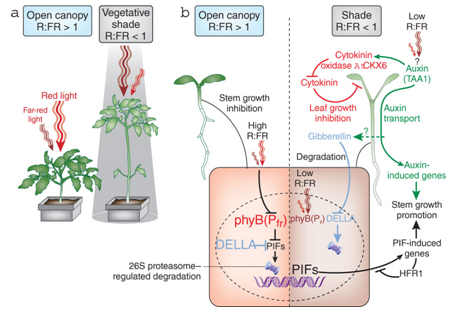
Figure 3. Interaction of phytochrome with hormones (Jaillais, 2010)
Therefore, FytoScope is equipped with a far-red light source in addition to white LEDs and red and blue LEDs. In addition to providing the best light quality for plant growth, while meeting the needs of plant light form building. In addition, FytoScope can provide three primary color light source systems with green LEDs and red and blue LEDs. By adjusting the ratio of the three primary colors, it can emit light of any color in the visible spectrum for the study of the effects of different light qualities on plants (Fig. 4).
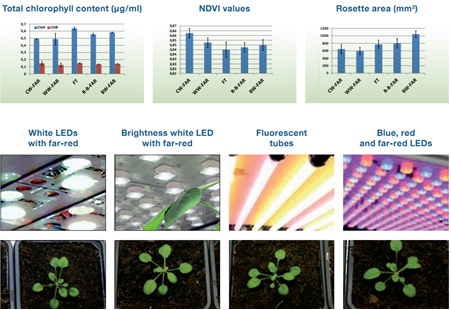
Figure 4. Growth and physiological indicators of Arabidopsis thaliana under different light sources
2) Light intensity
The incandescent lamp, tungsten halogen lighting effect is 12-24lm/W, fluorescent lamp 50-70lm/W, sodium lamp 90-140lm/W, most of the power consumption becomes heat loss. In theory, the luminous efficacy of the LED light source can reach 300 lm/W.
FytoScope LED light source plant incubator can achieve a maximum light intensity of 2000μmol (photons) / m2.s at a distance of 30-50cm, SL3500 LED light source can even reach a light intensity of 3000μmol (photons) / m2.s or more, from algae , Arabidopsis to wheat, corn, rice and other high-light-tolerant plant culture needs, and can carry out a variety of high light / low light stress experiments.
3) Control of light source and temperature and humidity
In traditional light sources, fluorescent lamps cannot regulate light intensity, and the light intensity can only be roughly controlled by increasing or decreasing the number of lamps, and accurate experiments cannot be performed. Although incandescent lamps and tungsten halogen lamps can adjust the light intensity, they are not very suitable for plant cultivation due to reasons such as spectrum and temperature rise.
FytoScope can precisely control the intensity and illumination time of each monochromatic light separately, and can realize dynamic stepless regulation through software, simulating changes
in light environment such as day and night cycle changes,
rising sun and sunset, and various other arbitrary changes. At the same time, the temperature and humidity can also change with the intensity of the light, simulating the temperature change in the day and night cycle (Figure 5).

Figure 5. The day and night cycle compiled in the FytoScope software and simulates the rising sun
4) Other advantages of LED light source
1The power supply voltage is lower, the power supply voltage is only 6-24 V, which is safer than using high voltage power supply;
2 energy-saving and efficient, the power consumption is only one-eighth of incandescent lamps, one-half of fluorescent lamps;
3 can emit pulsed light in a very short time, and the response time is fast;
4 small size, compact structure and strong stability;
5 non-polluting, as an all-solid illuminant, free of metal mercury, impact resistant, not easy to break, waste can be recycled, is a green lighting product;
6 long life, up to more than 50,000 hours, dozens of times more than ordinary lighting fixtures.
2. Ventilation and culture gas composition control
The ventilation of the traditional incubator is done by a fan. The larger the incubator is, the larger the fan is needed. This will create a strong airflow in the incubator, which will cause some disturbance and stress to the growth of the cultivated plants. FytoScope uses a new laminar air exchange system to ensure that the airflow rate in the incubator is no higher than 0.25 m/s, minimizing the effects of ventilation airflow on plants.
Traditional incubators can only provide plants with air in the natural environment, and the composition of the gas varies greatly, not to mention the composition. But for many scientists who study the effects of the greenhouse effect or other gases on plants, they need to precisely control the gas components of the plants. The FytoScope is equipped with the GMS150 high-precision gas mixing system that controls the gas concentration in up to four growth chambers. The standard version controls air/nitrogen and CO 2 , and other gas control functions can be configured according to user needs. The system has a built-in high-precision mass flow meter with a regulation accuracy of more than ±2% and a stability of more than ±0.1%. When studying the greenhouse effect, the CO 2 concentration can be precisely controlled to the ppm level.
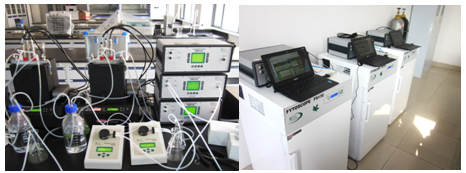
Figure 6. Left: FMT150 algae cultivation and online monitoring system with GMS150; right: FytoScopeLED light source growth box with GMS150
3. Plant physiology and phenotypic monitoring
Traditional incubators can only be used for general cultivation of plants, and physiological and ecological monitoring data related to plant growth cannot be automatically obtained during the cultivation process. Researchers are also required to take the plants out for manual measurement. Not only is it labor intensive, but it also interferes with the cultivation process of the plant.
FytoScope is equipped with an MP100 chlorophyll fluorescence automatic monitor. The MP100 has built-in measurement programs for fluorescence studies in the world, including Ft, QY, OJIP, NPQ, and light response curves. It can be used for photosynthetic activity research, long-term monitoring of plant photosynthetic capacity under natural environmental conditions, plant stress detection, herbicide testing, and plant growth monitoring under artificial or field conditions.
Researchers can use FytoScope to design different day and night cycles, changes in light quality/light intensity, high temperature/low temperature stress, gas composition, etc., and then monitor the plant fluorescence physiological indicators through MP100 in real time to complete a complete plant physiological experiment. This allows FytoScope to complete an experimental process alone and become a true scientific instrument, unlike traditional incubators, which are just tools for cultivating experimental materials.
For large growth chambers, it can also work in conjunction with the PlantScreen High Throughput Plant Phenotypic Analysis System. PlantScreen's high-throughput plant phenotyping system is the epitome of the latest plant phenotype and crop breeding research techniques. It integrates LED plant intelligence culture, automated control system, RGB true color 3D imaging, chlorophyll fluorescence imaging measurement analysis, phytothermal imaging analysis, plant near infrared imaging analysis, plant hyperspectral analysis, automatic bar code recognition management, automatic weighing and watering A number of advanced technologies, such as systems, to achieve high-volume plant samples in an optimized manner—from the model plant Arabidopsis to large-scale crops such as wheat and corn, to the full range of physiological and morphological structures, for plant phenotypic groups A comprehensive, automated, high-throughput, unattended long-term research analysis that captures and studies all relevant massive data on physiological changes and phenotypic analyses of plant life history. It has been equipped with many multinational seed companies such as many research institutes and Monsanto in the world. It is the most widely used and most comprehensive high-throughput plant phenotyping system in the world.
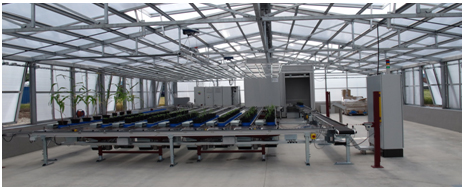
Figure 7. PlantScreen High Throughput Plant Phenotypic Analysis System
If you need to purchase lamps in bulk, please contact us.WOSEN is a professional manufacturer and supplier of Led Flood Light, Led Street Light, Led Solar Light, etc. For more information, please visit https://www.wosenled.com/ or contact admin@wosenled.com or WhatsApp +86-13425434349


 Plant culture is one of the most important routine basic experiments in biological laboratories. In previous studies, only the culture system was required to enable the seeds to germinate and basically satisfy the growth of the plants. However, in the study of truly rigorous plant physiology and ecology, traditional incubators are far from being able to meet the requirements for various reasons.
Plant culture is one of the most important routine basic experiments in biological laboratories. In previous studies, only the culture system was required to enable the seeds to germinate and basically satisfy the growth of the plants. However, in the study of truly rigorous plant physiology and ecology, traditional incubators are far from being able to meet the requirements for various reasons. 







